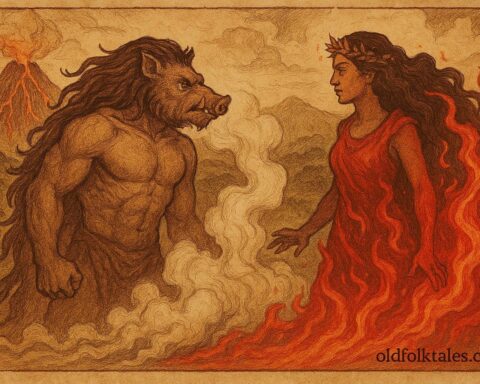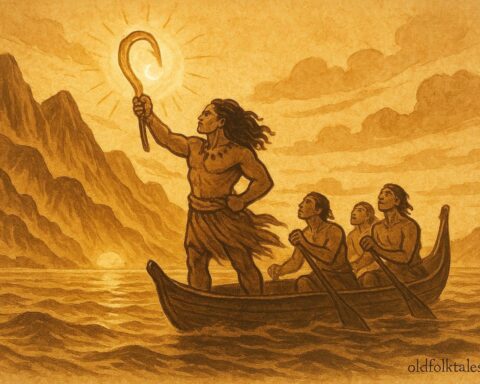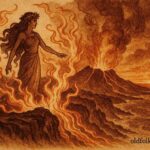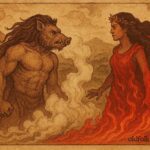Long before Western ships touched the shores of Hawai‘i, when the gods still walked unseen among the mountains and valleys, there lived a cruel and arrogant chief. His name is lost to time, for his deeds brought him only shame. He ruled over a lush valley surrounded by ancient forests, where birds nested in sacred trees and the night echoed with the soft calls of pueo, the Hawaiian owls, guardians of wisdom and protectors of the innocent.
In that valley stood a grove dedicated to Pueo, the Owl God. The grove was kapu, sacred, a place where no human dared to harm a tree, hunt an animal, or make loud noise. The people believed that the spirits of their ancestors rested there, and that the owls who lived among the branches were their watchful eyes.
Sail through the legends of brave navigators, ocean spirits, and island gods
But the cruel chief feared neither gods nor spirits. His heart was hard with pride, and his ears were deaf to counsel. What began as arrogance soon became sacrilege.
The Chief’s Desecration
One day, the chief ordered his men to cut wood from the sacred grove to build a new house of pride, grander than any in the islands. His priests pleaded with him, saying, “My lord, that forest belongs to Pueo, the guardian of the night. The owls will not forgive trespass.”
The chief laughed. “Are we to fear birds?” he mocked. “Their wings cannot fight spears. Their cries cannot stop my men.”
With that, he strode into the grove, snapping branches beneath his feet. His warriors followed, swinging their axes at the oldest trees. The air filled with the sound of cracking wood and falling timber. The owls rose from the branches in frightened swarms, their wings beating the twilight air like a storm.
That night, when the villagers looked toward the forest, they saw the trees quivering though no wind blew. They heard the low, mournful hoots of a thousand owls circling the desecrated grove. An omen had been given, and ignored.
The Warning of the Owl Guardian
As darkness deepened, a great shadow descended from the mountains, the spirit of Pueo, the Owl Guardian. His wings spanned the sky like dark clouds, and his golden eyes burned with divine fire. He spoke not in words but in thought, a voice that entered the hearts of all who lived in the valley.
“Why have you torn the feathers of the forest?” the voice echoed. “The grove was sacred, the breath of your ancestors. You have struck against life itself.”
The villagers trembled and fell to their knees. But the chief stood tall, laughing into the night. “You are but an omen,” he shouted. “No spirit can stand against the will of man.”
Pueo’s eyes narrowed. “Then you shall learn what becomes of those who mock the sacred.”
The Gathering of the Owls
Word spread across the islands, carried by the wind, whispered through trees, echoed by the waves. The call of the Owl Guardian summoned every owl in the land. From the cliffs of Kaua‘i to the lava fields of Hawai‘i Island, they came. Brown owls, white owls, fierce-eyed forest owls, thousands upon thousands took to the skies, their wings like thunderclouds across the moon.
The people of nearby villages watched in awe as the owls gathered above the chief’s valley, their cries filling the night like a war chant. “Hu! Hu! Pueo ka lani!”, “Owl of the heavens!” they cried. The night became alive with feathers and fury.
The Night of the Battle
At midnight, when the moon was high, the owls descended. The chief’s warriors, seeing the dark shapes blotting out the stars, raised their spears and torches in fear. But the torches flickered and died beneath the beating of wings. Then came the storm, claws flashing, wings slashing, cries piercing the air.
The warriors struck at shadows, but for every owl they struck down, ten more appeared. The sky itself seemed alive with vengeance. The owls blinded the men, tore at their faces, tangled in their hair, and sent them stumbling into the underbrush.
The chief, enraged, shouted to his men to stand firm. Yet even he could not see in the whirlwind of feathers. His spear flew from his hands. He fell to the ground, covering his face as the owls swarmed around him. When the dawn came, the valley was silent except for the soft coo of the morning doves. The chief’s house was in ruins, his warriors scattered. Not one owl remained.
The Lesson of the Grove
When the people ventured into the grove, they found it untouched by fire or blade. The fallen trees had been restored, their leaves green again, their roots drinking from fresh rain. In the center of the forest stood a single white owl, silent and still. When the people bowed in reverence, it spread its wings and rose into the sky, vanishing into the sun.
From that day onward, the valley became a place of peace. The people rebuilt their homes with humility, taking wood only from fallen trees. They tended the land with gratitude, for they knew the gods watched over those who honored the sacred.
As for the chief, no one knows what became of him. Some say he fled into the mountains, never to be seen again. Others say the owls carried his spirit away, leaving his body behind. The people called the place Ka Lua Ho‘omau o Pueo, The Lasting Pit of the Owl, in memory of the divine retribution that restored balance to the world.
Moral Lesson
The Battle of the Owls teaches that arrogance against nature and the sacred leads only to ruin. Respect for the land, its spirits, and the creatures that dwell within it ensures harmony and protection. When humanity forgets reverence, the natural world remembers justice.
Knowledge Check (Q&A)
- Who is Pueo in Hawaiian mythology?
Pueo is the divine Owl Guardian, a protector spirit symbolizing wisdom and justice. - What sacred place did the chief desecrate?
He destroyed Pueo’s sacred grove, a kapu forest where owls and ancestor spirits dwelled. - Why did the owls attack the chief and his men?
To avenge the desecration of their sacred home and restore balance between humans and nature. - What does the owl symbolize in Hawaiian culture?
The owl represents ancestral protection, guidance, and divine retribution against wrongdoing. - What lesson does this folktale teach?
That disrespecting nature or sacred places leads to downfall, while reverence brings harmony. - What is the meaning of “Ka Lua Ho‘omau o Pueo”?
It means “The Lasting Pit of the Owl,” commemorating the place of divine vengeance.
Source: Adapted from Hawaiian Folk Tales: A Collection of Native Legends edited by Thomas G. Thrum (1907).
Cultural Origin: Hawaiian (Polynesian)












